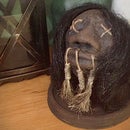Introduction: Bigfoot Footprint Cast
My wife is in the planning stages of decorating our entryway in an outdoors theme, focusing on plants, animals, and things native to the Pacific Northwest where we live. So far it's mostly Audubon style prints. I decided to help her out and make a realistic Bigfoot footprint cast to hang. She just loves those TV shows where they spend week after week hunting Bigfoot with infrared cameras and never find anything but stories or clumps of hair they can't attribute to anything but a big smelly "Squatch".
Step 1: Materials
- 2 inch thick rigid foam insulation
- X-acto knife
- X-acto curved blade woodcarving knife
- disposable retractable utility blades
- Hand saw
- Coping saw
- Tape
- Sand
- Plaster or Fix-All
- Bucket
- A plastic tub (optional)
- Wire brush, Chisels (optional)
- Bigfoot print template (provided)
Attachments
Step 2: Print and Transfer
Cut a piece of your foam board to 16 inches x 8 inches. Download and print out the provided Bigfoot footprint template. There is a template for both a right and a left footprint. Each one will requite two sheets of regular letter size paper, so you'll have to cut them out and tape them together together. Keep in mind you'll be flipping your carved foot over to press it into the ground or sand to make your casting mold, so the templates are backwards. Tape the template to your piece of foam and use your X-acto knife to trace the outline of the foot and each of the toes.
Step 3: Cut It Out
Use a coping saw or the utility knife to cut out the shape of the foot. I tried to cut outside the lines and leave a little extra that I could shave off with the utility and X-acto knives.
Step 4: Shape the Foot
I like things nice and smooth when I carve foam, and i tend to get the best results using a disposable utility knife, fully extended, with a slicing motion to essentially shave off slices of foam. I used the straight X-acto knife to cut and remove the bulk of the foam between the toes and followed up with the curved woodcarving knife, again with slicing strokes to smooth things out.
Step 5: Make Your Sand Mold
Fill the plastic tub with a couple inches of damp sand and smooth it flat. Place your footprint carving onto the sand and push and twist it lightly into the sand. Take handfuls of the remaining sand and pack it around the foot until level with the top. Pound on the foam a few times with your fist then repack the sand. I screwed a couple screws into the foam so i could pull it out. Wiggle the foam lightly and lift to remove.
Step 6: Fill Your Mold
Mix your casting material with enough water to make it the consistency of pancake batter. I like using Fixall for this as it's easier for me to find than plaster and usually cheaper, and it sets pretty quick. I mix it in a bucket with my hands so I don't introduce lots of air bubbles. Usually when you cast something like this you'd want to tap or vibrate the air bubbles out after you pour, but that would collapse the sand. So in this case, I recommend mixing by hand. Once thoroughly mixed pour into your mold, and let it set up.
Step 7: Finishing Up
If you pull your cast footprint out while it's not completely hardened it's easer to wire brush off the sand. Use a knife or chisel to remove any major defects, or to reshape to your liking. Why did I do this? Who knows. It was fun. I think I'll make the other foot and take them hiking with my girls to leave behind footprints :)

Participated in the
Hand Tools Only Contest

Participated in the
Teach It! Contest Sponsored by Dremel














